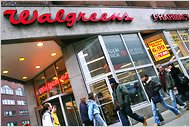 Michael Nagle/Bloomberg NewsThe American drugstore chain Walgreen Company agreed on Tuesday to buy a 45 percent stake in Alliance Boots, the European pharmacy retailer.
Michael Nagle/Bloomberg NewsThe American drugstore chain Walgreen Company agreed on Tuesday to buy a 45 percent stake in Alliance Boots, the European pharmacy retailer.
LONDON – Europe’s capital markets are in the doldrums. Uncertainty caused by the Continent’s financial crisis has led to a big fall in initial public offerings, while investors remain wary of buying sovereign and company debt.
Yet there’s one area where Europe is shining.
So far this year, the total value of mergers and acquisitions on the Continent by foreign companies has reached $101 billion, well ahead of the combined $73 billion spent in the United States by international acquirers, according to the data provider Dealogic.
While the total value of European deals this year has slipped 20 percent compared with the same period in 2011, the number of acquisitions by foreign suitors is back to the levels at the height of the financial boom in the mid-2000s. In contrast, the value of deals in the United States by foreign companies announced so far this year is still 50 percent less than the $144 billion recorded over the same period in 2007.
As the European debt crisis has been felt across capital markets, the asset prices of many local companies have tumbled. Analysts say this fall in equity values has made some Europe companies takeover targets for overseas companies. The Euro Stoxx 50 index, which comprises the largest companies in the euro zone, has fallen 20 percent over the last 12 months.
Faced with economic tumult, the Continent’s companies have been looking to offload assets to shore up their capital reserves. Local banks are keen to sell so-called noncore assets, like real estate loan portfolios, while industrial companies have been mulling the disposal of international units.
American companies have been taking advantage. Acquirers in the United States have spent a combined $43.7 billion on deals in Europe so far this year, or around 43 percent of the total value of takeovers on the Continent. If Canadian companies are included, North American companies represent just under 60 percent of the buyers of European targets.
On Tuesday, the American drugstore chain Walgreen Company agreed to buy a 45 percent stake in Alliance Boots, the European pharmacy retailer, for $6.7 billion, in a deal that will allow both companies to extend their worldwide reach. United Parcel Service also is acquiring TNT Express, a Dutch shipping company, for 5.2 billion euros, or $6.6 billion.
Despite the increase in deals, bankers say acquirers remain cautious about what acquisitions to pursue. So-called bolt-on deals in the same industry that have minimal risk connected to them have become the main focus of attention. Transformational deals into new sectors, which involve large amounts of debt financing and concerns about how successful they will be, face tough opposition.
Unlike acquisitions in the United States, which are focused in the healthcare, technology and food and beverage industries, deals for European companies are spread across a number sectors. Traditional takeover targets, like mining companies and energy utilities, remain popular, but other sectors, including telecoms and construction, also have recorded high volumes of deal activity, as international buyers look to take advantage of Europe’s financial woes.
Article source: http://dealbook.nytimes.com/2012/06/20/amid-debt-crisis-overseas-buyers-seek-european-companies/?partner=rss&emc=rss

